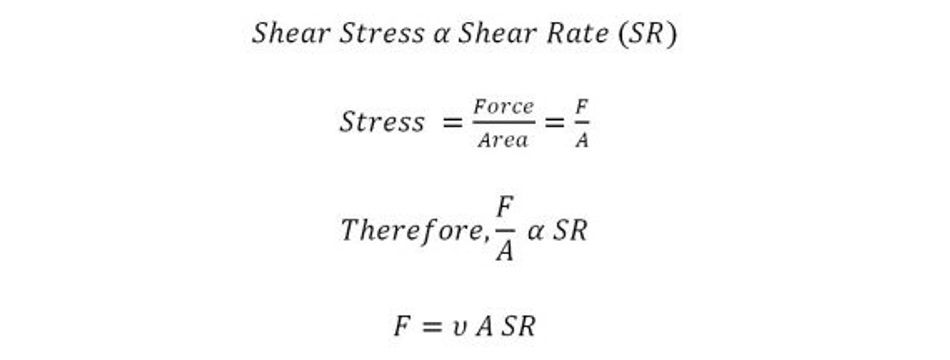Kinematic Viscosity
In simplest terms, the viscosity of a fluid is the measurement of its resistance to deformation at a specified rate.
This article was first published on
www.engineeringclicks.comIn simplest terms, the viscosity of a fluid is the measurement of its resistance to deformation at a specified rate.
For liquids, viscosity directly corresponds to its “thickness.” Custard, for example, has a greater viscosity than syrup, and syrup has a greater viscosity than water.
To visualise viscosity, you can picture the internal frictional forces that occur between all of the adjacent flowing fluid layers. For example, if a thick fluid is pushed through a pipe, the flow will be faster near the center of the pipe, as opposed to near the walled edges. In this case, some kind of stress needs to occur to keep the flow moving, such as a difference in pressure between either end of the pipe. In other words, a force is needed to overcome the frictional resistance. The strength of that force is proportional to the fluid’s viscosity.
What is kinematic viscosity?
Kinematic viscosity is a measure of how much a fluid internally resists flow under the influence of no outside forces other than gravity.
Kinematic viscosity is determined by measuring the time (in seconds) it takes for a specified volume of an individual fluid to flow a given distance through a calibrated viscometer, due only to the force of gravity. The testing must be done in a temperature-controlled environment with the temperature specified along with the kinematic viscosity value.
Measures of viscosity and kinematic viscosity are used frequently in engineering fluid dynamics and for practical applications such as oil flow through pipelines.
Kinematic viscosity equation
The kinematic viscosity equation is:
v=𝜇/p
where v = kinematic viscosity, 𝜇=dynamic viscosity, p =density
Kinematic viscosity is measured in units of (length)2/time – most commonly using centiStokes (cSt), where 1 Stoke = 1 cm2/s.
When used in this equation, the viscosity μ is often referred to as dynamic viscosity or absolute viscosity.
Common kinematic viscosity values
The table below contains kinematic viscosity values for some common fluids.
| Fluid | Temperature (oF) | Temperature (oC) | Kinematic Viscosity in centiStokes (cSt) |
| Ammonia | 0 | -17.8 | 0.30 |
| Butane | -50 | -1.1 | 0.52 |
| Castor Oil | 100 | 37.8 | 259 – 325 |
| Coconut Oil | 100 | 37.8 | 29.8 – 31.6 |
| Diesel fuel 2D | 100 | 37.8 | 2 – 6 |
| Fuel oil 1 | 70 | 21.1 | 2.39 – 4.28 |
| Gasoline a | 60 | 15.6 | 0.88 |
| Honey | 100 | 37.8 | 73.6 |
| Ink, printers | 100 | 37.8 | 550 – 2200 |
| Kerosene | 68 | 20 | 2.71 |
| Mercury | 70 | 21.1 | 0.118 |
| Milk | 68 | 20 | 1.13 |
| Olive Oil | 100 | 37.8 | 43.2 |
| Rapeseed Oil | 100 | 37.8 | 54.1 |
| Turpentine | 100 | 37.8 | 86.5 – 95.2 |
| Water, fresh | 60 | 15.6 | 1.13 |
| Water, distilled | 68 | 20 | 1.0038 |
Kinematic viscosity in Newtonian and non-Newtonian fluids
A Newtonian fluid is one that keeps a constant value of viscosity across all shear rates. They get this moniker because they follow the formula set out by Isaac Newton in his law of fluid mechanics.
Fluids that don’t exhibit constant viscosity across all shear rates are known as non-Newtonian fluids.
Examples of some Newtonian fluids are gases, oil, water, alcohol, petroleum, etc.
Examples of some non-Newtonian fluids include:
- Shear-thinning fluids – the viscosity decreases when the shear rate increases. E.g. wall paint – as you stir wall paint, it becomes increasingly fluid and liquidy.
- Shear-thickening fluids – the viscosity increases when the shear rate increases. E.g. corn starch combined with water – it gets thicker when stirred faster fluid.
- Rheopectic fluids – these increase in viscosity when shaken, e.g. printer ink.
- Thixotropic fluids – decrease in viscosity when shaken, e.g. tomato ketchup.
Difference between kinematic viscosity and dynamic viscosity
Kinematic and dynamic viscosity measurements serve different purposes in calculations. In simple terms:
- Dynamic viscosity lets you work out the force needed to make a given fluid flow at a certain rate. Its units come out as mass/(distance*time).
- Kinematic viscosity allows you to work out the speed at which the fluid moves when a certain force is applied. It has units of area/time.
Newton’s Law of Viscosity states that shear stresses between parallel layers of fluid are proportional to the corresponding velocity gradients. The ratio of shear stress to shear rate is defined as the viscosity.
In other words:
In Newton’s Law of Viscosity equation, the proportionality constant is μ or dynamic viscosity.
Kinematic viscosity has units of diffusivity, (length)2/s, which means that kinematic viscosity is sometimes known as diffusivity of momentum, dependent on thermal and mass diffusivity. This leads us to the fact that dynamic viscosity is a constant property, but kinematic viscosity is a derived property.

